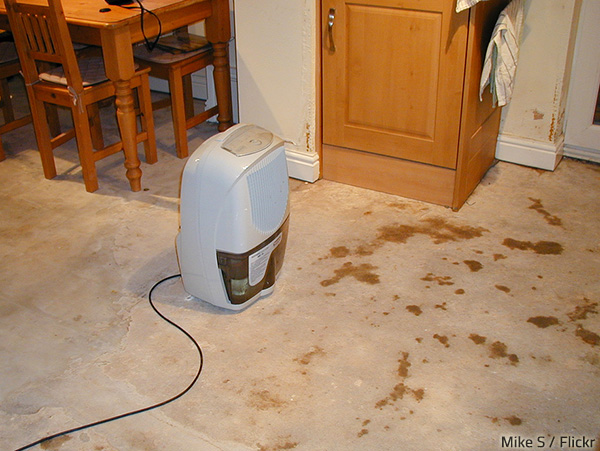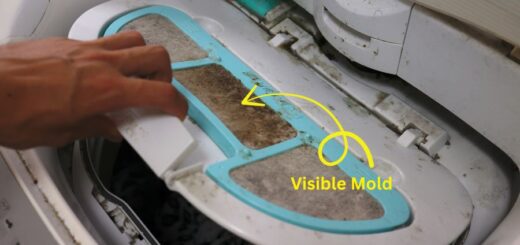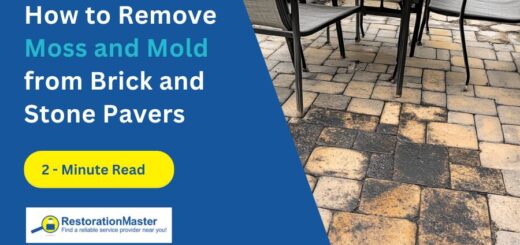How Long Does It Take for Mold to Grow
Excess water in the home – whether because of floodingFlooding is the overflow or accumulation of water in areas t... More, a burst pipe, or a leaky roof – always causes a lot of trouble. It may compromise the integrity of the building, destroy electronics and appliances, and ruin furniture, carpeting, clothing and other household items. And as if the water damage is not enough, moldMold is a type of fungus that grows in damp or humid conditi... More quickly begins to grow inside the home, increasing the damage and making the restorationRestoration is the process of returning a property to its pr... More process longer, harder, and costlier.
Mold Growth After Water Damage

Water damage can cause all sorts of problems in a home.
Even if the water intrusion is limited and does not cause considerable damage, it may still result in a moldMold is a type of fungus that grows in damp or humid conditi... More problem – any amount of moisture accumulation indoors can easily leadLead is a heavy metal that can be toxic to humans, especiall... More to mold growth in the home. MoldMold is a type of fungus that grows in damp or humid conditi... More sporesSpores are microscopic reproductive units of fungi or mold t... More exist everywhere in the environment, so moldMold is a type of fungus that grows in damp or humid conditi... More can start developing as soon as the right conditions – organic “food” and moisture – are present.
There are plenty of porousPorous describes a material that contains small openings or ... More organic materialsOrganic materials are derived from living organisms, such as... More in a house – drywall, insulationInsulation is a material used in buildings to reduce the tra... More, paint, paper products, etc. – so all that is needed for moldMold is a type of fungus that grows in damp or humid conditi... More to start growing is some moisture. Only a few inches of water (or even just high humidityHumidity is the amount of moisture or water vapor present in... More) can create the necessary conditions for moldMold is a type of fungus that grows in damp or humid conditi... More growth – then, it takes just a couple of short days for moldMold is a type of fungus that grows in damp or humid conditi... More to develop and start damaging your property.
Yet, the problem can be easily avoided – all you need to do is eliminate the moisture before moldMold is a type of fungus that grows in damp or humid conditi... More has had the chance to start developing. But how quickly does moldMold is a type of fungus that grows in damp or humid conditi... More grow? How soon do you have to dry the premises to prevent the sporesSpores are microscopic reproductive units of fungi or mold t... More from taking root in your home?
How Long Does It Take for Mold to Grow?
To be able to prevent moldMold is a type of fungus that grows in damp or humid conditi... More problems after a water incidentAn incident is an event or occurrence that causes damage, di... More, you need to know not only how long it takes for moldMold is a type of fungus that grows in damp or humid conditi... More to form, but also how quickly it can affect your household items and materials:
How fast can mold grow?
Under ideal conditions (optimal temperature and level of humidityHumidity is the amount of moisture or water vapor present in... More), it takes 24 to 48 hours for moldMold is a type of fungus that grows in damp or humid conditi... More to germinate and grow. Typically, the sporesSpores are microscopic reproductive units of fungi or mold t... More begin to colonize in 3 to 12 days and become visible in about 18-21 days. Of course, the time varies for different types of moldMold is a type of fungus that grows in damp or humid conditi... More and depends on the actual conditions in the home – the type of surfaces and household materials in the affected area, the amount of moisture, the ambient temperature, etc. Nevertheless, the more time passes, the greater the chance for moldMold is a type of fungus that grows in damp or humid conditi... More to develop and spread to other areas of the home.
How fast does mold spread?
MoldMold is a type of fungus that grows in damp or humid conditi... More spreads in as little as a few hours. When a moldMold is a type of fungus that grows in damp or humid conditi... More spore lands on a moist organic material, it roots into the porousPorous describes a material that contains small openings or ... More surface and begins to feed off the organic substance. Within hours, the harmful microorganisms start spreading to adjacent moist areas, damaging the structural integrity of the material they’re attached to. Once moldMold is a type of fungus that grows in damp or humid conditi... More gets a foothold on a surface in your home, it quickly fills the air with thousands of sporesSpores are microscopic reproductive units of fungi or mold t... More that spread throughout the building, affecting more and more areas with every passing hour.
So, the only way to prevent moldMold is a type of fungus that grows in damp or humid conditi... More from infesting your home following an incidentAn incident is an event or occurrence that causes damage, di... More with water damage is to dry the premises within the first 48 hours after the water intrusion.
How to Keep Mold from Growing After Water Damage?
From the above, it can be concluded that there is a 48-72 hour window between the water intrusion and the beginning of moldMold is a type of fungus that grows in damp or humid conditi... More growth. If the flooded areas are completely dried off within this time-gap, moldMold is a type of fungus that grows in damp or humid conditi... More has very little chance to develop.

DryingDrying is the process of removing moisture from materials, s... More the flooded areas within the first 48 hours after the incidentAn incident is an event or occurrence that causes damage, di... More can prevent moldMold is a type of fungus that grows in damp or humid conditi... More from forming.
Proper drying, however, is quite difficult. Water can find its way into all kinds of materials and spread into walls, under floors, and through ceilings on its route to the lowest point in the house.
1. Extract excess water
Extracting the excess water from the home and opening a door or window to allow air flow from the outside will not dry out these inaccessible areas in time. And if any amount of moisture, however small, remains lingering inside the wall cavities, behind the baseboards, or under the carpet padding, moldMold is a type of fungus that grows in damp or humid conditi... More will have more than enough time to start developing before it all dries up.
2. Dry out the area
Besides, people usually focus their efforts on dryingDrying is the process of removing moisture from materials, s... More the room that was flooded and neglect nearby areas where water may have flowed hidden inside wall cavities or under carpet or tile. So, even if a person thinks that the property is dried out, enough moisture may be left behind to allow moldMold is a type of fungus that grows in damp or humid conditi... More to start growing.
To successfully remove all excess moisture from your home in the 48-72 hour window when dryingDrying is the process of removing moisture from materials, s... More can prevent moldMold is a type of fungus that grows in damp or humid conditi... More from forming, you’re going to need professional drying services. The experts have the technical know-how and the specialized equipment needed to safely remove standing water, locate hidden issues, and thoroughly dry your home, preventing further damage and moldMold is a type of fungus that grows in damp or humid conditi... More growth.
Professional Water Damage Cleanup and MoldMold is a type of fungus that grows in damp or humid conditi... More Removal
At RestorationMaster, we use industrial air movers and dehumidifiers to evaporate the moisture from the affected materials and then draw that moisture from the air and pump it out of the home, thus stopping moldMold is a type of fungus that grows in damp or humid conditi... More from forming in your property. Our highly effective tools, procedures, and techniques allow us to keep dryingDrying is the process of removing moisture from materials, s... More times to a minimum – and faster dryingDrying is the process of removing moisture from materials, s... More means less time and smaller chance for moldMold is a type of fungus that grows in damp or humid conditi... More to develop, which helps avoid costly repairs and health problems that occur as a result of fungal contaminationContamination is the presence of harmful or unwanted substan... More.
You can count on RestorationMaster for water damage cleanup, dryingDrying is the process of removing moisture from materials, s... More services, moldMold is a type of fungus that grows in damp or humid conditi... More growth evaluation, damage containment, mold removal, and moldMold is a type of fungus that grows in damp or humid conditi... More damage mitigation in Omaha, NE, and the surrounding areas.
Call us at (402) 973-3858 for more information about our water damage restoration and mold removal and remediation services.












